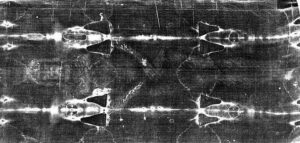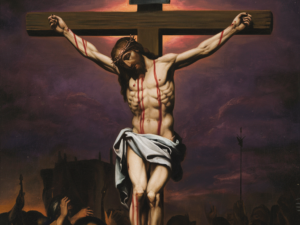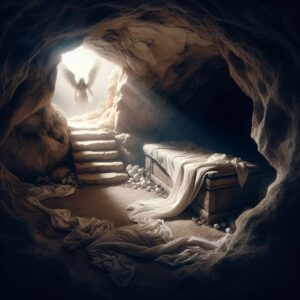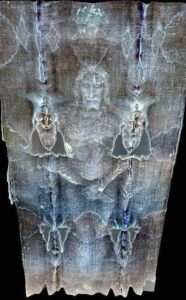
1353, Lirey, France, Geoffroi de Charny, a battle-hardened knight and crusader, reveals a linen cloth, 14 feet long, marked with a faint image of a crucified man. Bloodstains, whip scars, a pierced side, no paint, no dye. Science cannot copy it. X-rays peg it at 2,000 years old, lasers fail to match it. The Shroud of Turin, Christ’s burial cloth or a medieval trick? Geoffroi dies in 1356, fighting at Poitiers, leaving no hint of its origin. How did it travel from a Jerusalem tomb to his hands, 1,300 years later? Let us step back.

Pre-dawn Jerusalem, near Golgotha, days of madness peak. Friday, Jesus dies. Earth quakes, tombs split, dead saints rise and walk the city (Matthew 27:51-53). Guards posted that night (Matthew 27:65-66) are already rattled. Sunday, a massive quake strikes again. An angel, bright as lightning, rolls a heavy tombstone aside and sits on it (Matthew 28:2-4). Those tough Roman or Temple soldiers collapse in terror. Swords drop, some run, others freeze, “like dead men.” The tomb is open, Jesus is gone, risen. Inside are burial linens, a folded head cloth (John 20:6-7). Who took them?

The Suspects
- Joseph of Arimathea: Wealthy disciple, Sanhedrin member, owns the tomb (Matthew 27:60). He provides the linen, buries Jesus with help (John 19:38-40). The quake is close. He is nearby, maybe half a mile away. Odds: high, 60-70 percent alone, higher with a partner.
- Nicodemus: Pharisee, brings 75 pounds of spices for burial (John 19:39). Teamed with Joseph, his odds jump, 10-20 percent solo, up to 70-80 percent together.
- Mary Magdalene: First there, sees the empty tomb (John 20:1), stays to meet Jesus (20:11-18). Brave, but no resources, 40-50 percent chance.
- Peter: Runs in, sees the cloth, leaves fast (John 20:6-10). Impulsive, unlikely, 20-30 percent.
Joseph is my bet. The tomb is his, and the guards’ panic leaves it unguarded. Nicodemus likely aids him, slipping in after Mary and Peter leave, around 6-8 a.m. They grab the linen because of faith, not greed, before Romans or priests can destroy it.
The Trail
Joseph hides it. Early Christians scatter under pressure (Acts 8:1). Hints emerge: a face-cloth in Edessa, 2nd century; a blood-stained shroud in Constantinople, 944, lost in the 1204 Crusade sack. Templar rumors swirl. Geoffroi’s uncle died with them in 1314. Then, 1353, Geoffroi has it. No clear path, just echoes.
Back to Geoffroi

His family keeps it after his death, passing it to the Savoy dynasty in 1453. It lands in Turin, 1578. Pope takes it in 1983. Science stumbles: 1988 carbon dating (medieval) falters, fire damage and repairs skew it, while X-rays point to Christ’s time. A knight held what a disciple saved, 1,300 years apart. The Shroud’s mystery burns. What do you think?

Eager for the next charge? Join me on my next quest—history’s shadows, faith’s fire, mysteries untold. What’s your battle?
Sources & Further Reading:
The Shroud of Turin by Andrea Nicolott
Report on the Shroud of Turin by John Heller

I’m extremely impressed together with your writing talents and also with the structure for your blog. Is this a paid subject or did you modify it yourself? Anyway stay up the nice quality writing, it’s uncommon to look a nice blog like this one today!